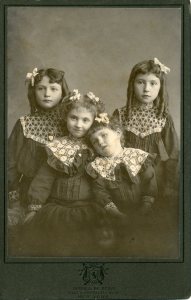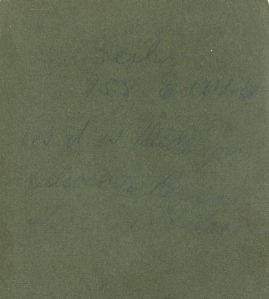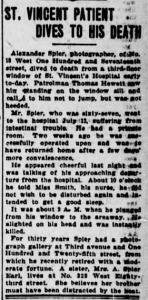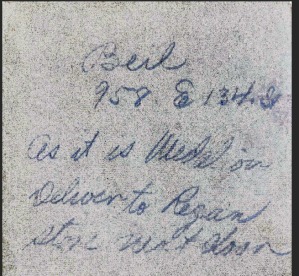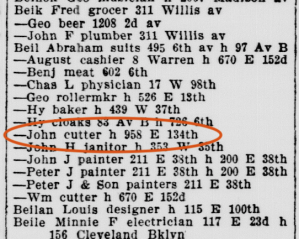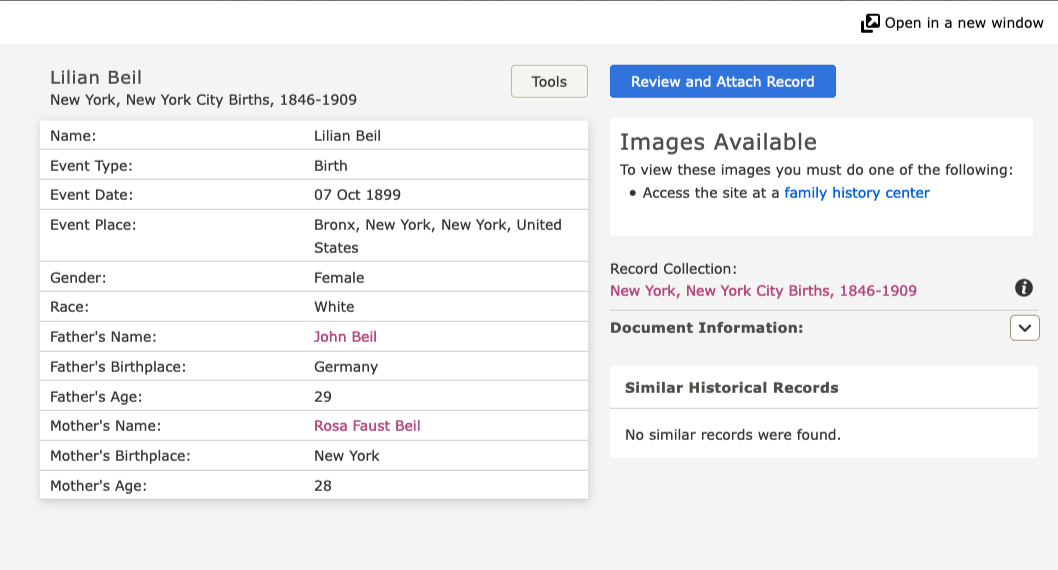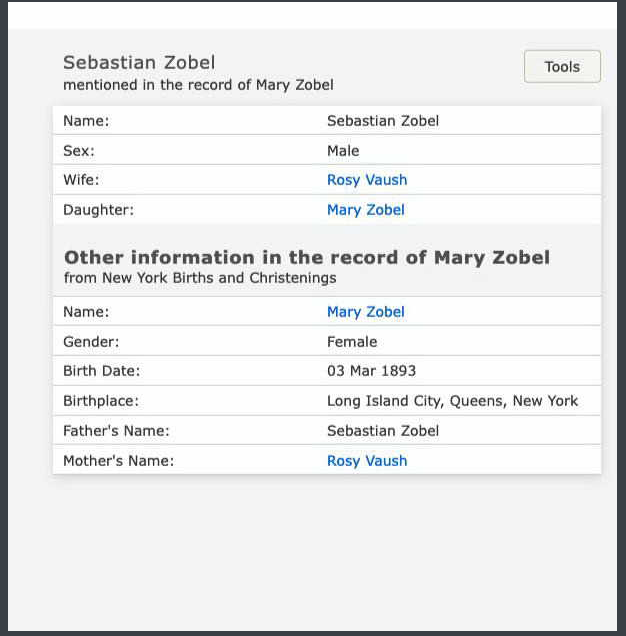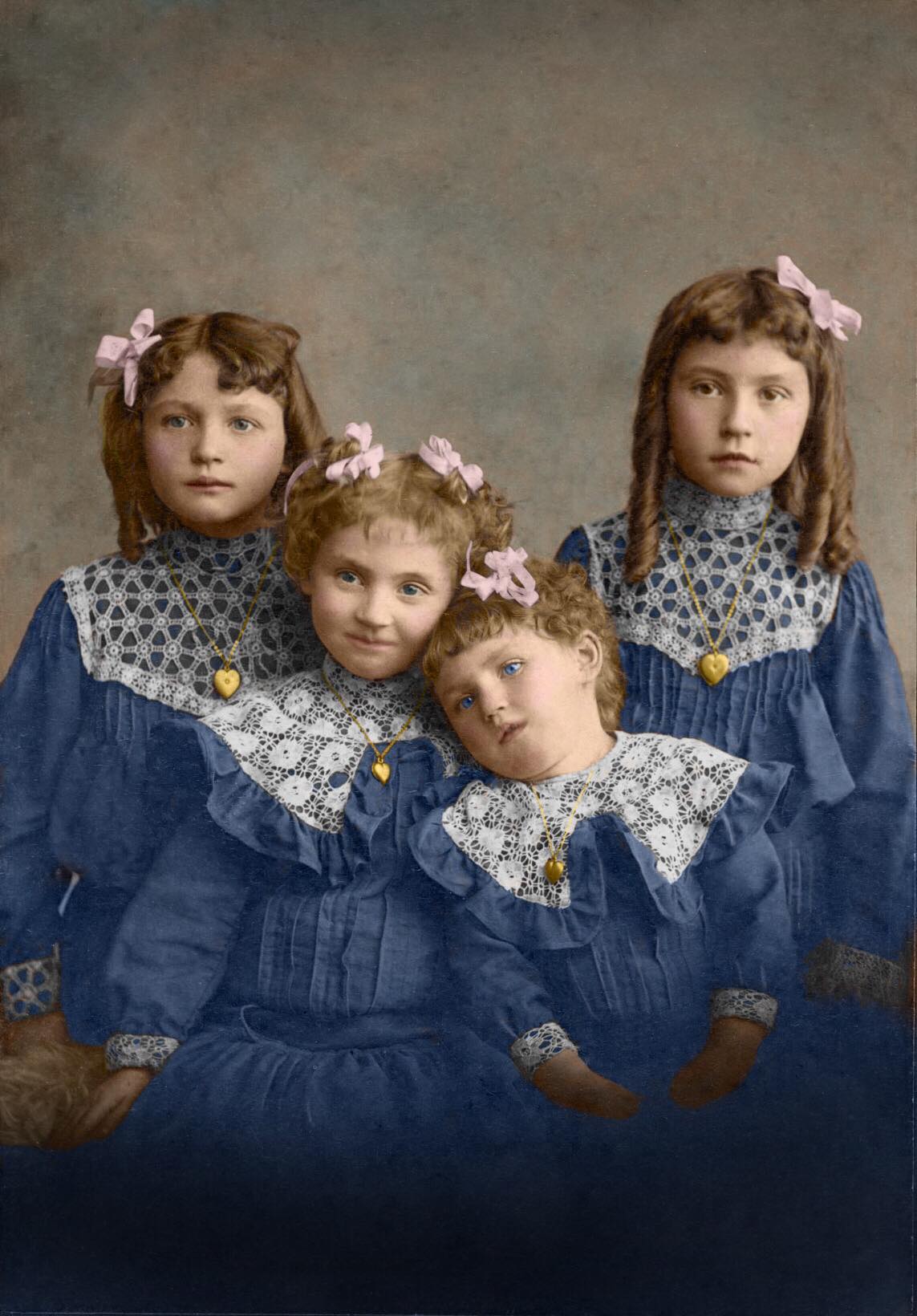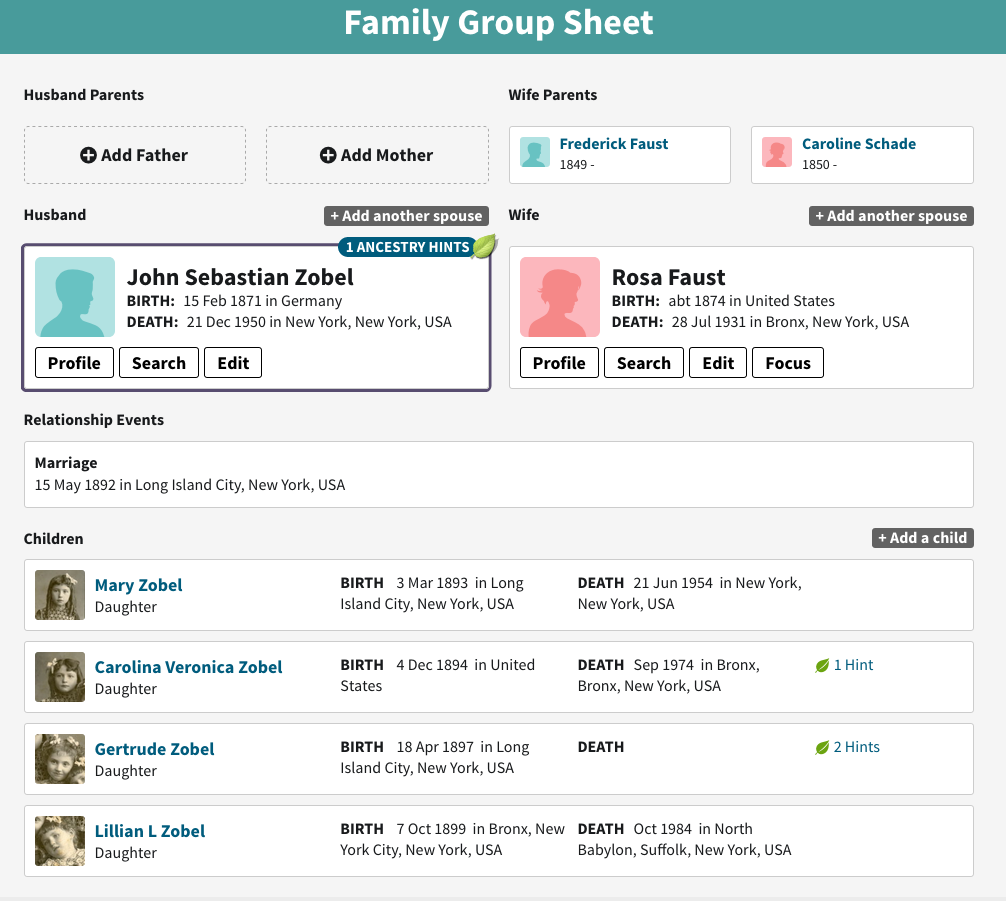It all started with a picture. To be honest, it started when I joined a Facebook group called Forgotten Faces, Forgotten Places. FFFP is a group of dedicated volunteers who rescue old photos from thrift shops, off eBay, yard sales, and even the side of the road. The goal? To find a welcoming descendant and send those treasures home. It feels good to reunite a photo with family and to be honest it can be addicting to do the research.
So yes it all started with a picture. Oftentimes there is little information to go on and many a photo languishes waiting to be identified and sent home. For the cabinet card that captured my eye, there was little information to go by — just a possible name and address.
Beil — 958 E 34th St — As it is a medalion deliver to Regan store next door.
Photographer is Spier & De Bear, New York, New York. At least with a photographer and a city to go by, there is a chance to identify these girls. I started out eagerly with these tidbits of information so sure that I could find a descendant in no time. I couldn’t have been more wrong.
Starting with the photographer and while I never found that particular collaboration, I did find quite a bit about Alexander Spier. Spier was a well-known photographer who had his studio at 3rd Avenue in NYC for 30 years. Sadly, a career of that length generally does not help in photo identification. Alexander Spier ran his studio from the early 1880’s to his retirement in 1913. In August of 1913, Spier decided to take a swan dive off the 3rd floor of the St Vincent’s hospital to his death. His sister believed that her brother “may have been distracted by the heat”. Well even if I couldn’t narrow down the timeframe for this photo, at least there was much to be learned about this photographer and how newspapers reported events of the day.
So next to my favorite search sites – Ancestry.com and FamilySearch.com. I exuded overconfidence in my search queries as I boldly moved forward making an assumption about the date of the photo (late 1880’s/early 1890’s) and approximate birth year of the father. Search after search turned up empty for possibilities. Understand that I just knew that the family name was ‘Beil’ and of course would always be that name. Lesson #1: modern conventions and laws don’t apply to the history of 100+ years ago.
Nothing ever turned up even remotely for that assumed address. After several off and on days of searching, I pondered again the image of the back of the photo. The writing was faint so what could I do to improve that? Photoshop to the rescue! Normal image adjustments of brightness, contrast, levels, black & white, etc. were not sufficient to draw out the text so I did my equivalent of a Hail Mary and used Replace Color. This technique allowed me to isolate the background color from the handwriting color and create a contrast. It did take several color replacements to get to the right level but as you can see in the image on the right, it worked out well. The address was not 34th street but 134th street — a very important clue and one that allowed me to eventually track down this family.
The New York City Public Library has digitized 148 years of city directories. I’d like to take a moment and give props to all our public libraries. I often make use of the services of local libraries when trying to track down an ancestor and the information contained in their archives both local and digital is pure gold to the researcher. As with many publicly funded projects, libraries tend to be underfunded so please consider a donation to your local library and any other library you use in your research.
With address in hand and a 30 year potential span of directories to search, I realized I needed help which is Lesson #2: don’t be afraid to ask for help. Facebook has a plethora of closed groups with members who can help in a search. I posted the picture to Genealogy- Dating old photographs with the hopes of narrowing down the date of the photo. The group did not disappoint with a consensus of early 1900’s. Armed with this information, I started to randomly view the city directories between 1900 and 1910 and looking for variations of the name – Beil, Biel, Bell. The random viewing occurred at night when my husband was watching some sporting event and I the ever dutiful kept him company. The directories are finicky to view on a phone so there were many frustrating moments but persistence paid off when I found a single entry in the 1900/1901 New York City Directory:
Back to the city directories and my search for a family. While I love that the directories are digitized, for the most part they have not been indexed. What I’ve found that is searchable doesn’t lend itself well to unusual spellings such as the name ‘Beil’ (trust me – I tried).
With renewed vigor, I began my searches anew and included Findagrave.com and Newspapers.com. On Ancestry.com every time I created a new search, I received differing results which leads me to Lesson #3: Always create a new Ancestry.com tree. Once I’d established a tree, I found that my search results (while quite thin for accuracy) improved.
Even with this new information, finding credible information was difficult. I began to think that this family just didn’t want to be found. I turned to yet another Facebook group – New York Genealogy Network – and followed my rule of asking for help. My query? What was a cutter given the person lived in New York City. While they did not come up with what I determined to be John Beil’s actual occupation, the group did provide a wealth of information on various occupations at the turn of the century and one tip which is Lesson #4: Make judicious use of wildcard searching when possible. While wildcard searching is not new to me, as I mentioned previously I’ve been exuding overconfidence so it was a head-slap moment when reminded to use this technique.
Thank you FamilySearch for reasonable indexing and search facilities. Say hello to the Beil family with a different spelling in the 1905 census.
How do I know this is the same family? Same address as the 1901 city directory and the writing on the back of the cabinet card. Also same profession (cutter) and same first name. And if you look closely, there are 4 daughters listed whose ages line up with the estimate of when the photo was taken. Is this enough information to say for sure it’s the same family? I’m a firm believer in multiple sources of information and especially wary of census records and the New York City directories did no disappoint. We have a new spelling for Beil which leads again to Lesson #1. Unfortunately, I could not find this family in the 1900 nor 1910 census at that 134th street home with those potential last names. Time for more digging.
It was FamilySearch.com that gave up the first “good bits” of information including a birth record for the youngest daughter, Lillian.
Names, dates, places – this was my anchor and a springboard for more searches. I’ll spare the gory details but in the end I found 3 birth records and am still looking for Gertrude’s. FamilySearch.com has quite a bit of indexed data and I find the searching to be more flexible which leads to Lesson #5: Use FamilySearch.com searching to your advantage. I find the ability to search a large range of years plus relationships to be invaluable. The results are visually easier to process with the distinction between collections and records. Before I get the standard “but Ancestry has that too” comments, I’d like to say that this is a personal preference. I have had significantly more success on FamilySearch and part of it is the ease in viewing and refining search results.
One aspect of Ancestry.com that I do like is tree management which is both a bane and a boon. After I’d created the family tree with information gleaned so far, Ancestry.com began alerting me to hints on possible matches. None were a match and worse, the suggested other family trees were all poorly researched — some with nothing more than a poorly transcribed census record as the sole record. Guess what? Lesson #6: Do NOT blindly accept trees found on Ancestry.com.
Between the city directories which I now scoured year by year and New York and US census records, I was able to determine that this family moved from 958 East 134th Street (a rental) to 678 East 134th Street (a rental) to their final owned home of 727 East 141st Street. All in the Bronx and within blocks of each other. Another discovery I made was that none of the girls were able to finish high school and it wasn’t until their children went to school that any member of this line completed their education. By 1910, Mary can be found out of school and working as a knitter in a factory. According to the 1940 census record, Mary only completed the 7th grade.
Mary’s sisters shared similar stories as both Carrie and Gertrude would become an operator in a handkerchief factory and Lillian was a “forelady” in a piano factory. Lillian would complete the highest level of education with 2 years of high school.
There were name changes along the way but fortunately there were overlapping records between census and city directories so that I could follow this trail. John’s listed profession was cutter from 1900 on until his retirement / unemployment. By the 1910 census, the last name was listed as Sobel though this is likely a mistake in transcription and should be Zobel. How does one go from Beil to Beyhl to Beyho to Sobel to Zobel? Understanding the times helps considerably. John was born in Germany and immigrated in his teen years. So there would be language considerations. Census takers were notoriously bad at name spelling. Names changed when societal attitudes towards a country or religion changed. So many reasons but it all harkens back to the mantra of do not assume that there is any consistency in spelling. As a side note, the US social security act had a huge impact on naming conventions. A person had to start proving identity in order to contribute and collect which led to more consistent spellings.
Zobel. In the end, that is the surname John entered the country with and used on his marriage certificate to Rosa Faust. Once I accepted that the last name could be Zobel, I could now track this family pre-1900. In the 1900 census, the family is listed as Byhle and John was a brick layer. Those lines that tie everything together did exist though with family member names, ages and the most important – 958 East 134th Street. Before Lillian’s birth in 1899, the family used John’s surname of Zobel in all the records I found from marriage to birth to census.
There was one more surprise to be found and that for a time in the early 1890’s, John used Sebastian as his first name. This is intriguing as his middle initial is often listed as ‘S’. How do I know that this Sebastian Zobel is the one and same as John S Zobel? Again those threads that bind everything together. Birthdates, locations, names which when taken singly prove nothing but when put together and compared with all other dates, names and locations proves that Sebastian Zobel was indeed John Zobel.
I have many more records with a variety of spellings but it does all add up. I wouldn’t make these leaps of faith if there weren’t secondary records to support my findings.
So what’s in a name? At the turn of the 20th century, perhaps not much for an immigrant and his family. I wonder if the move from Long Island City, Queens into the Bronx meant that the name needed to change for societal reasons. Sebastian became John and Zobel became Beil. Once established in their own home, it was clear that John wanted to reclaim some part of his roots as he went from Byhle back to his original surname of Zobel. Maybe. Or maybe I’m violating Lesson #1 and am imposing my own modern assumptions on events of over 100 years ago.
Final Notes:
There were many times I abandoned the search for this family. Remember there are literally thousands of photos waiting to go home. So why this one? Why find this particular family? In the end it came down to a random act of kindness when Peter Pietro Mantione on Facebook gifted me with a colorized version of the Zobel family photo.
This photo was likely taken around 1901 and here we are in 2019 staring at the faces of 4 young girls with their whole lives ahead of them. I couldn’t thank Peter enough as this was the impetus I needed to continue on the search for a family and perhaps finally a home.
And for those who like completion, here is a partial look at the family tree I’ve built. I have one marriage record to confirm (Gertrude) but other data is complete. I hope to one day track John Zobel back to his homeland and continue the family tree.
Going Home
I’m happy to report that the original cabinet card photo will be going home. A descendant of Lillian Zobel has been located and is thrilled to offer this cherished photo a place back in the family. All those long hours of searching have paid off with the result we hope for. We are no longer “Finding Home” but “Going Home”.
The End
Resources Used
Facebook Groups: Forgotten Faces, Forgotten Places; Genealogy- Dating Old Photographs; New York Genealogy Network
Ancestry.com: Created new tree to ensure better search results
New York Public Library Digital Archives – NYC City Directories
Dr Stephen Morse’s Unified Census ED Finder: References can be by residence number & street address. Returns links to the relevant census record pages in both Ancestry and FamilySearch. Extremely useful when unsure of names or looking at succession of residence.
Newspapers.com (minimal information)
Office of the New York State Comptroller – Unclaimed Funds
DuckDuckGo – my favorite search engine
Plus many other smaller sites for name origination, historic European country borders, historic city maps, etc.

